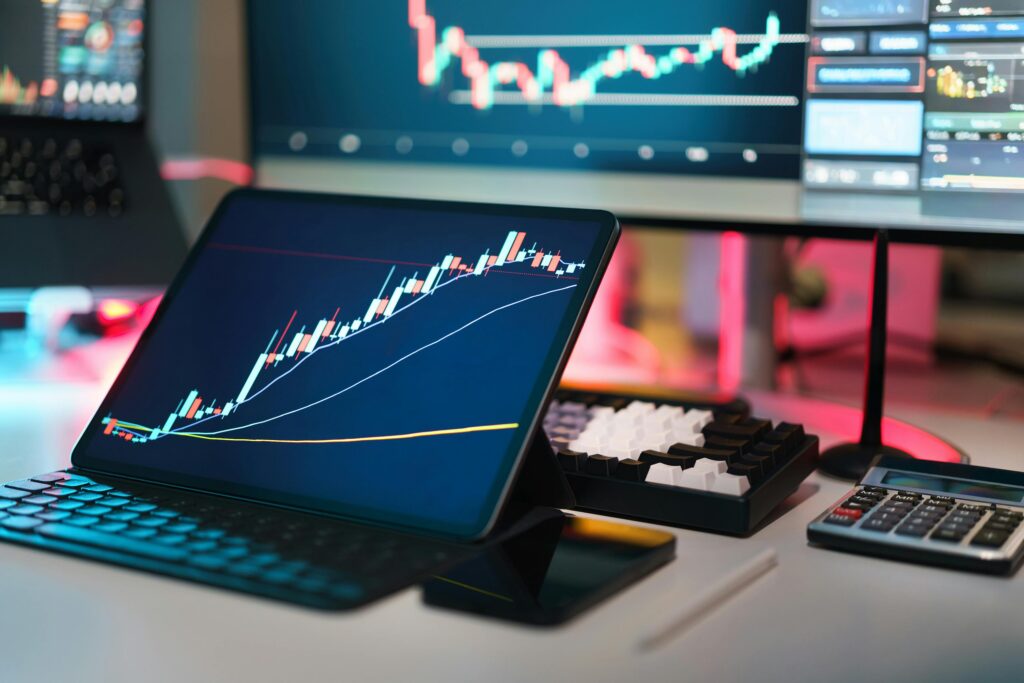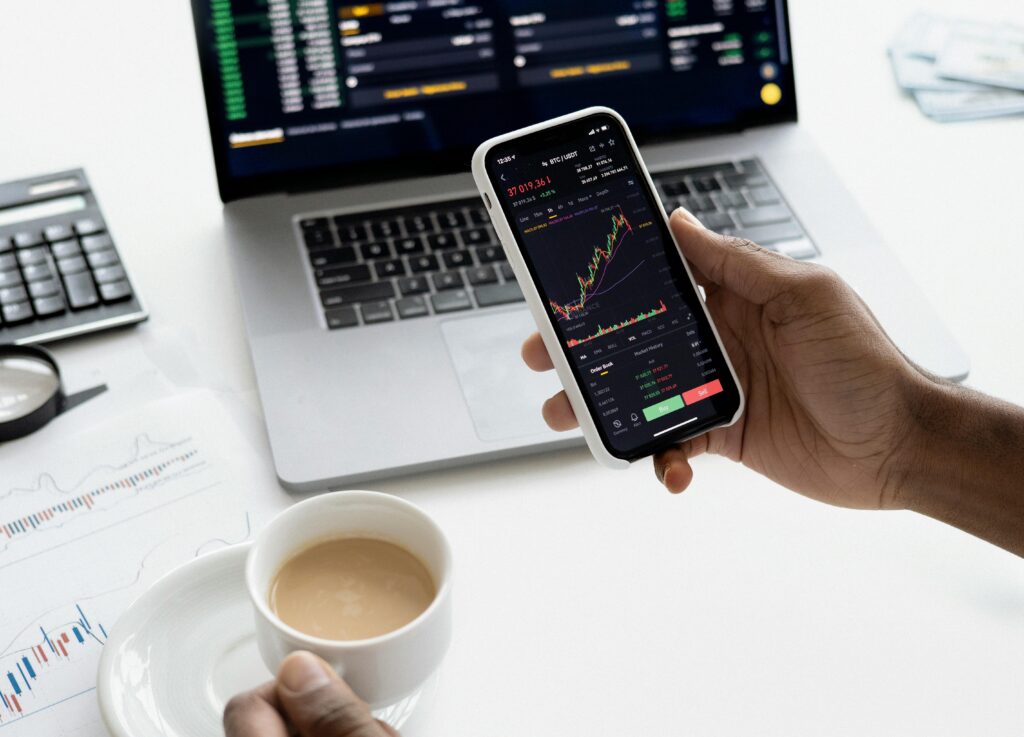Entering the world of currency trading can feel daunting, but it’s an exciting financial arena once you grasp the basics. This article breaks down the forex market in simple terms—what it is, how it works, key terms and strategies, how to get started, and common mistakes to avoid. Whether you’re a young aspiring trader or just forex-curious, you’ll find a friendly guide below to help you understand currency trading.
What Is the Forex Market?
Forex trading often happens via digital platforms, allowing traders to monitor currency prices on screens. The foreign exchange market, or forex (FX), is the global marketplace for exchanging national currencies. The forex market is huge – in fact, it’s the largest financial market in the world, with an average daily trading volume of around $7.5 trillion as of 2022.
For perspective, this dwarfs the trading volume of stock markets. Another key aspect is that forex is a 24-hour market, operating continuously five days a week (from Sunday night to Friday evening across time zones). This round-the-clock schedule is possible because trading moves from one major financial center to another (e.g. London, New York, Tokyo), making forex highly liquid and accessible nearly any time.
So what’s actually being traded? Currencies are always traded in pairs. For example, if you trade the EUR/USD pair, you’re speculating on the value of the euro relative to the U.S. dollar. If the price of EUR/USD is 1.10, it means 1 euro is worth $1.10. In every trade, you are simultaneously buying one currency and selling another.
How the Forex Market Works

Understanding how forex trading works will make you more comfortable as a beginner. Unlike stock exchanges, the forex market has no central exchange or physical location – it operates through a global network of banks, brokers, and financial institutions electronically.
A few characteristics make forex unique:
- Leverage: Forex brokers typically offer leverage, meaning you can control a large position with a smaller amount of money (margin). For instance, 50:1 leverage allows you to trade $50,000 in currency with only $1,000 of capital. Leverage can amplify profits and losses, so use it cautiously.
- Low Costs: In retail forex, trading fees are often built into the spread – the small difference between the buy (ask) and sell (bid) price for a currency pair. Major currency pairs (like EUR/USD, GBP/USD, USD/JPY, etc.) usually have tight spreads (fractions of a cent), making transaction costs low.
- Liquidity: The major currency pairs are extremely liquid (easy to buy/sell quickly) due to high trading volume. This liquidity means you can enter and exit positions quickly, but it also means prices can move rapidly when market-moving news hits.
In essence, forex trading involves trying to buy low and sell high (or vice versa) on currencies. Traders use various information to predict currency moves, including economic data (like inflation, employment figures), central bank policies, news events, and technical analysis of price charts.
Key Terms and Basic Strategies
Before diving in, it helps to learn some key forex terms you’ll encounter:
- Pip: A pip is the smallest price move in most currency pairs, typically the fourth decimal place (0.0001). For example, if GBP/USD moves from 1.2500 to 1.2515, it rose 15 pips. Pips measure your profit or loss.
- Leverage & Margin: Leverage means borrowing funds from the broker to increase trade size; margin is the deposit you need to open a leveraged trade. E.g., 30:1 leverage lets you open a $30,000 position with $1,000 margin. Higher leverage = higher risk.
- Spread: The difference between the bid and ask price. If EUR/USD is quoted 1.2050/1.2052, the spread is 0.0002 (2 pips). You pay the spread cost when entering a trade.
- Long vs Short: Going long means buying a currency pair (expecting the base currency to rise). Going short means selling a pair (expecting the base currency to fall). For instance, long EUR/USD = buy euros/sell dollars; short EUR/USD = sell euros/buy dollars.
- Major, Minor & Exotic Pairs: Major pairs involve USD and another major currency (EUR, JPY, GBP, etc.) and are the most traded. Minor pairs are non-USD crosses (like EUR/GBP). Exotic pairs involve emerging market currencies (higher volatility and spreads).
- Stop Loss & Take Profit: A stop-loss order automatically closes your trade to limit loss if the price goes against you beyond a set point. A take-profit order locks in gains when price reaches a target. Using these is part of good risk management.
Besides terminology, new traders should grasp some basic strategies. Most strategies fall under two umbrellas: fundamental or technical. Fundamental trading means you base decisions on economic news and indicators. Technical trading relies on chart analysis – using price patterns, trends, and indicators to predict future movements.
How to Get Started with Forex Trading

For retail investors, the process of getting started in forex typically involves opening a trading account with a broker, funding it, and then placing trades. Below are some steps to help you start on the right foot:
- Learn the Basics: Begin with education. Take time to understand how currency trading works and key concepts like pips, leverage, and risk management. You can find free tutorials, videos, and articles online – for example, market 4 you offers beginner-friendly guides and resources to teach you forex fundamentals.
- Choose a Reputable Broker: Your broker is the platform through which you’ll trade, so pick carefully. Look for a well-established broker that is regulated in your country (e.g. by authorities like the FCA in the UK or CFTC in the US). A good broker will offer a user-friendly trading platform, competitive spreads, and reliable customer support.
- Practice with a Demo Account: Treat your demo trading seriously. Use it to get familiar with the trading platform’s features (how to execute orders, set stop-losses, analyze charts) and to test any strategies. Spend a few weeks or more in demo mode until you can trade consistently without major mistakes.
- Start Small with Real Money: When you’re ready to go live, start with a small amount of capital that you can afford to lose. Many brokers have very low minimum deposits (some even under $100). Trade small position sizes at first. The goal is to ease into real trading without risking too much while you gain experience.
- Implement Risk Management: Set rules for yourself to protect your account. This includes using stop-loss orders on every trade to cap potential losses, and limiting the amount you risk per trade (e.g. no more than 1-2% of your account). Avoid the temptation to dramatically increase your trade size after a win or to revenge-trade after a loss.
By following these steps, you’ll build confidence gradually and establish good trading habits from the start. Remember that forex trading is a skill – it takes time and practice to become proficient. Don’t rush the learning process, and don’t be afraid to stay in demo mode until you feel truly ready.
Common Mistakes to Avoid
Even with the best preparation, beginners can fall into several common traps in forex trading. Being aware of these mistakes can save you money and stress:
Overusing Leverage: One of the biggest lures in forex is high leverage – but it’s a double-edged sword. Excessive leverage can wipe out your account quickly. For example, a 1% adverse move on a 100:1 leveraged position can mean a 100% loss of your capital. Avoid the mistake of trading the maximum leverage available.
Letting Emotions Rule: Fear and greed are every trader’s worst enemies. It’s easy to get emotional – for instance, holding onto a losing trade hoping it will turn around (fear of loss), or overtrading after a big win (greed). Train yourself to stay disciplined. If you find yourself unable to stay objective, step away and take a break.
Chasing the Market: This mistake happens when you enter trades late, after a big price move, out of a fear of missing out (FOMO). Chasing momentum without analysis often ends in buying the top or selling the bottom. Instead, be patient and let trades come to you according to your strategy.
Ignoring Risk Management: Not using stop-loss orders, or risking too much on one trade, can be fatal for your account. Sometimes beginners get tunnel vision on potential profits and forget about limiting downside. Don’t make the mistake of thinking “it will come back” as losses mount.
It’s worth noting that due to these pitfalls, a large percentage of rookie forex traders end up losing money. In fact, as one Bloomberg analyst wryly observed, it’s extremely hard for retail traders to consistently make money in forex – many essentially make random trades and pay high spreads/fees, which practically guarantees a negative outcome over time. By managing risk diligently, staying disciplined, and continuously learning, you’ll give yourself a much better chance of success.
Conclusion
The forex market can be an exciting place for young traders and investors. It offers liquidity, flexibility, and opportunities to profit from global economic trends. However, it also requires knowledge, patience, and respect for the risks involved. Start by mastering the basics and practicing thoroughly. Treat trading like a business: have a plan, control your risks, and keep emotions in check. With time and experience, you can navigate the forex market with confidence. Happy trading!






